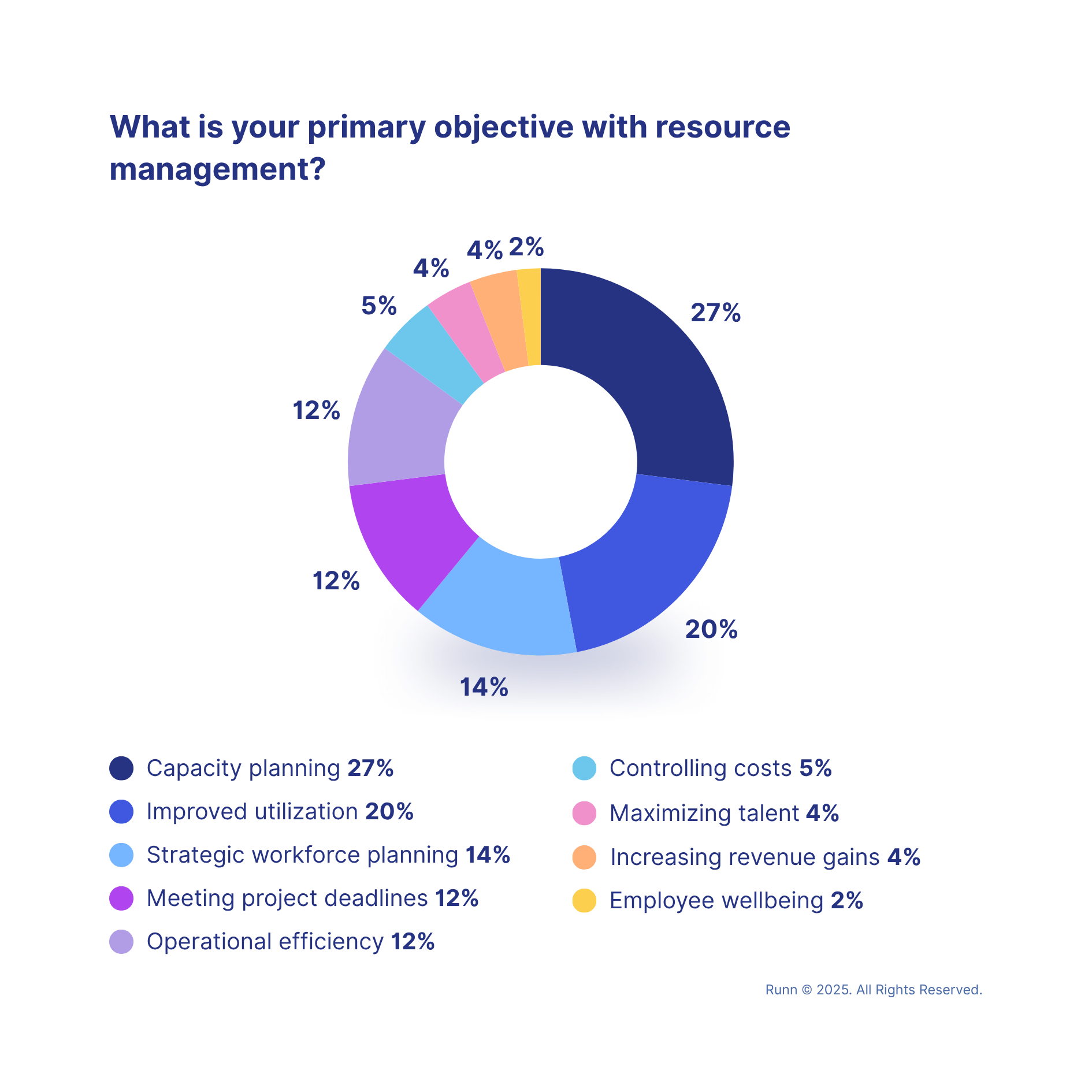How are businesses strategically building capacity and resilience in 2025? Here are the capacity planning statistics you need to know.

There’s a fine art to balancing your workforce’s capacity with current and future customer demand.
However, in Runn’s 2025 Resource Management Unfiltered Survey, two-thirds of organizations said forecasting and misalignment between capacity and demand are their biggest resource management challenges, while only 13% rated their forecasting as ‘extremely effective.’ Despite how central capacity planning is to business success, most teams admit they’re still struggling to get it right.
When you get capacity planning right, it creates avenues for sustainable business growth, improved talent development and retention, and maximized project profitability.
But done poorly, capacity management can quickly create all sorts of problems. From workload imbalance to under- and over-resource utilization, poor employee engagement, and blown project budgets, it stunts future growth and puts your organization on a path of decline.
Hard to believe? Let’s take a look at capacity planning statistics to review what fresh-from-the-oven research reveals about the current state of capacity planning, its benefits, and the role it plays in organizational growth.
Runn's wider report on The State of Resource Management in 2025 proves that capacity planning is a top priority for businesses. Almost half of respondents named tasks relating to matching supply to demand as their top resource management objective, pointing to a growing maturity in the discipline. Financial and people-centric goals languish lower on the list, suggesting a shift towards using resource management to align talent with future demand, not just today’s delivery needs.

In addition, 90% of leaders consider capacity building a pressing to-do that needs addressing now or soon per a McKinsey report. The same report also found only 5% of the surveyed folks think they’re all set to prioritize capacity building.
Gartner confirms the same. Strategic high-level workforce planning is among the top three organizational priorities for HR leaders in 2025, next only to leadership and organizational culture development.

But the current state of resource planning? Strewn with challenges and processes that not many leaders are satisfied with.
In a poll on one of our recent webinars on forecasting best practices for resource management, for example, we found:

Finding yourself in a similar boat? Here’s a comprehensive guide to strategic capacity planning.
Concerns like overworked employees and reduced capacity utilization prompting poor employee retention are setting the need for investing in capacity building. For instance:
Here’s more on the benefits of capacity planning ➡️
From lack of data to use for good capacity planning to not having the strategic processes to use, research shows there are a handful of factors stopping leaders from effectively planning their workforce:
Only 15% of companies do strategic workforce planning according to a Gartner survey of 1,400 HR leaders in 60+ countries and major industries. In turn, this makes it challenging for resource leaders to align their staff with long-term business objectives.
Per the data we shared above, Runn also found the same. Not many have strategic processes in place. Those who do, say their processes aren’t accurate enough.
It seems a leading reason behind the lack of a strategic capacity-building process is a lack of enough historical data or not knowing how to use the collected data.
In this vein, an old but trusty Gartner report surveying HR leaders reveals:
Fresh data from ActivTrak polls also goes on to reveal that 27% of the organizations that don’t collect activity data for capacity planning are unsure where to begin. 22% also point out that the cultural implications of tracking activity data are a concern.
For companies that have toes dipped in the capacity planning waters, proving their program’s worth is another challenge that hinders them from further investment.
In fact, 66% of resource leaders confirm their workforce planning process is limited to headcount planning and they find it hard to show ROI for their strategic planning work.
The result? Organizations end up investing less and less in demand and utilization planning despite realizing its worth.
Without a plan to prove ROI, leadership support and resource investment into workforce planning naturally go down. A lack of (stakeholder) awareness about how capacity building can shockproof your organization is a potential reason why resource leaders struggle.
Either way, McKinsey's research found all these factors are leading reasons behind stalled progress into capacity optimization:
.png)
Directly or indirectly, lack of capacity planning encourages several challenges including:
Data confirms it all:
Related read: Unlocking Employee Engagement: How to Build a Thriving Workplace ➡️
We now know that there’s research backing the many benefits of capacity management and the losses it can save organizations from.
But the way forward is strategy-led, powered by data collection and analysis — not random acts of workplace planning.
To get started, you’ll want to centralize your data analysis and resource capacity planning and management. Lattice reports highest-performing teams are 2.6 times more likely to invest in performance management software than the lowest-performing teams — confirming capacity planning software is indispensable to efficient workforce optimization.
With that, we’ll leave you with essential resources to help you get the ball rolling:
▶️ The Beginner's Guide to Capacity Planning for 2025 & Beyond